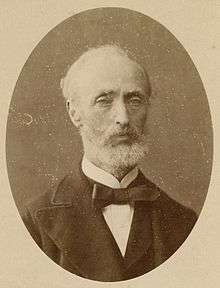George Tinline

George Tinline (28 October 1815 – 4 February 1895) was a nineteenth-century South Australian banker and politician.
History
Tinline was born near Jedburgh, Scotland, and on completing his education worked for twelve years in the Jedburgh branch of the Bank of Scotland. In 1838 he emigrated to Sydney, Australia, where he was employed by the Bank of Australasia. He was shortly transferred to the bank's Adelaide branch but was not long there when he accepted the position of accountant with the Bank of South Australia at £400 a year. In 1860 the manager Stephens left for England, and Tinline was appointed acting manager.[1] This was the time of the gold rush, and the Colony was beset with, apart from the shortage of workers, a financial crisis due to the sudden increase in the availability of gold and the lack of sufficient currency to pay for it. He pushed for the establishment of an assay office and mint, and the conversion of some of the diggers' gold to bullion which could be used as a form of currency.[2] A Bullion Act was passed and some 25,000 ₤1 coins were minted, but were not recognized as legal currency by the Bank of England. In recognition of his work in staving off a crisis Tinline was awarded a purse of 2,000 guineas (£2,200; several millions of dollars in today's money), and an elaborate silver salver (now in the Art Gallery of South Australia),[3] for his service to the business community.[4]
He was sacked by the bank in 1859 after severe losses caused by a customer defaulting,[3] and joined A. B. Murray in developing a pastoral lease at Wirrabara.
He was one of the Lands Commissioners when he was elected in April 1860 to fill one of two vacancies in the Legislative Council, then created a vacancy when he abruptly retired to England in May 1863. The house which he had commissioned near the summit of Mount Lofty was sold, half completed, later to become Stawell School for Girls.[5]
He paid a short visit to Adelaide in 1894 or 1895, and was in Melbourne when he died.
Family
Alexander Borthwick Murray married his sister Margaret Tinline (c. 1823 – 17 August 1907) on 23 June 1857 (his second wife).
John Tinline (ca.1792 – 14 December 1867), who died at Murray Park, Magill, may have been his father. (John Tinline and his daughter Margaret Tinline arrived in South Australia aboard the Symmetry in February 1844)[6]
George Tinline married Helen Madder (also of Jedburgh) on 30 November 1843. They lived on Stanley Street, North Adelaide[7] and had six children.[3]
References
- ↑ "Death of Mr. G. Tinline". The Advertiser. Adelaide: National Library of Australia. 6 February 1895. p. 7. Retrieved 31 August 2014.
- ↑ "Death of Mr. George Tinline". South Australian Register. Adelaide: National Library of Australia. 5 February 1895. p. 5. Retrieved 31 August 2014.
- 1 2 3 Christine Hirst, 'Tinline, George (1815–1895)', Australian Dictionary of Biography, National Centre of Biography, Australian National University, http://adb.anu.edu.au/biography/tinline-george-4725/text7839, published in hardcopy 1976, accessed online 31 August 2014.
- ↑ "The History of a Colonial Bank". South Australian Register. Adelaide: National Library of Australia. 11 April 1892. p. 6. Retrieved 31 August 2014.
- ↑ Barbara Wall A Short History of Stawell School: The forgotten school on Mount Lofty published for Mount Lofty Districts Historical Society by Peacock Publications 2012 ISBN 978--1-921601-69-9
- ↑ "Obituaries of the Week". The Observer (Adelaide). LXIV, (3,438). South Australia. 24 August 1907. p. 38. Retrieved 8 August 2016 – via National Library of Australia.
- ↑ "Family Notices.". Southern Australian. Adelaide: National Library of Australia. 12 December 1843. p. 2. Retrieved 31 August 2014.